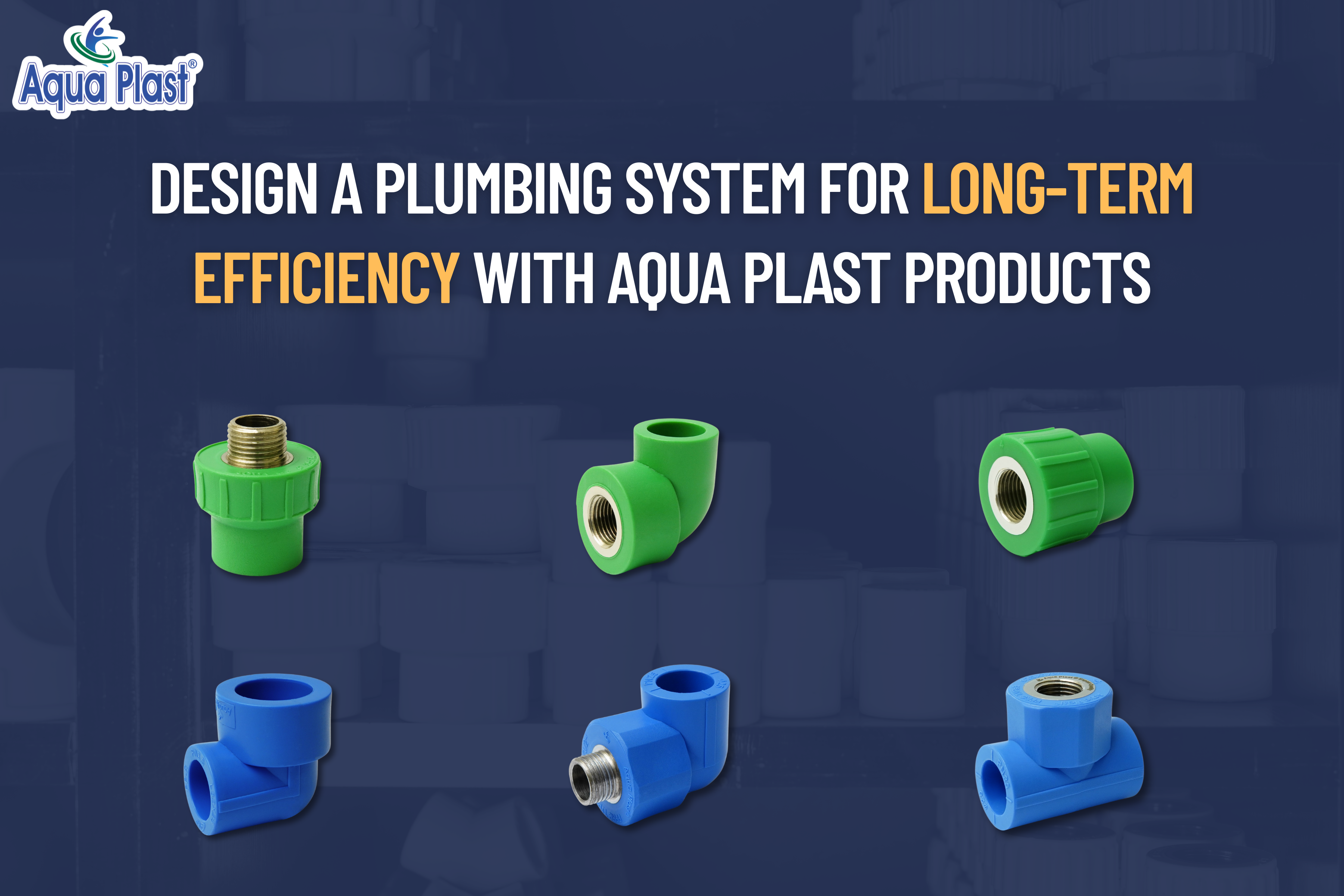How to Design a Plumbing System for Long-Term Efficiency with Aqua Plast Products
In modern construction—whether residential, commercial, or industrial—an efficient plumbing system is not a luxury but a necessity. It ensures uninterrupted water supply, minimizes maintenance, prevents water damage, and saves energy and resources. However, the long-term performance of any plumbing system depends heavily on smart design, quality materials, and correct installation.
Aqua Plast, a trusted name in Pakistan’s plumbing industry, offers a complete range of PPRC, UPVC, and PVC pipes and fittings, water tanks, and bathroom products. With durable materials, advanced manufacturing, and eco-conscious engineering, Aqua Plast is the go-to choice for builders, plumbers, and engineers aiming to create long-lasting plumbing networks.
In this blog, we will explore how to design a long-term efficient plumbing system using Aqua Plast products from start to finish.
1. Planning the Plumbing System: Layout Comes First
Efficient plumbing begins with careful planning. Whether you’re constructing a new building or upgrading an old one, you need a detailed layout that includes:
- Water source location
- Pipe routing for hot and cold water
- Drainage and waste management
- Fixture placement (toilets, sinks, showers, etc.)
- Tank location (for storage and gravity pressure)
- Access points for maintenance
Aqua Plast provides a wide range of pipe sizes (25mm to 110mm) and fitting types (elbows, tees, couplings, valves, etc.) suitable for diverse layouts. The right layout minimizes pipe length, avoids sharp bends, and maintains balanced pressure throughout the building.
2. Choosing the Right Type of Pipe: PPRC vs. UPVC vs. PVC
Aqua Plast offers three main types of piping solutions:
PPRC (Polypropylene Random Copolymer):
- Ideal for both hot and cold water systems
- Resistant to heat (up to 95°C), chemicals, and corrosion
- Long life span (up to 50 years)
- Suitable for residential, commercial, and industrial buildings
- Available in pressure ratings like PN-16 and PN-20
UPVC (Unplasticized Polyvinyl Chloride):
- Best for cold water distribution and drainage
- Non-corrosive and lightweight
- Smooth interior surface for better flow
- Cost-effective and easy to install
PVC (Polyvinyl Chloride):
- Mostly used for sewage, waste, and rainwater drainage
- Excellent for underground pipework
- Resistant to chemicals and heavy flow
Choosing the right material for the right job is essential for longevity. For instance, using PPRC for hot water and UPVC for drainage avoids unnecessary wear or breakdown.
3. Selecting Fittings and Accessories: Avoid Weak Points
Pipes are only as good as the fittings that connect them. Weak or low-quality fittings are the biggest causes of leaks, pressure drops, and system failures. Aqua Plast manufactures a complete set of fittings for every piping system, including:
- Elbows and Tees – for changing pipe direction and branching
- Couplings and Reducers – for joining pipes of the same or different sizes
- End Caps – to seal unused pipe ends securely
- Gate Valves and Full Bore Valves – to control water flow and pressure
- Threaded Fittings – for connections with pumps or metal equipment
Aqua Plast fittings are made from virgin raw materials, not recycled plastics, ensuring durability, heat resistance, and tight seals. The hot-melt technology used to join PPRC fittings creates a leak-proof bond that becomes one with the pipe—no extra glues or tapes needed.
4. Pressure and Flow Management: Avoid Water Wastage
Long-term plumbing efficiency depends on consistent water pressure. If the pressure is too low, appliances won’t work correctly; if it’s too high, fittings may burst or leak over time.
To manage this:
- Use Full Bore Valves from Aqua Plast that match the internal diameter of the pipe, ensuring no reduction in flow.
- Install gate valves where water zones split to isolate areas when maintenance is needed.
- Place non-return valves in vertical lines to prevent backflow.
- Use properly sized water tanks at adequate heights for gravity-based pressure if a pump system is not used.
Aqua Plast’s valves come in several pressure ratings, such as PN-16 and PN-20, designed for both residential and industrial-grade systems.
5. Insulating and Supporting the System
Over time, external conditions like temperature changes and pipe movement can affect your plumbing system. Here’s how to ensure your Aqua Plast pipes last:
- Use pipe insulation on exposed PPRC lines to reduce heat loss and prevent cracking during cold weather.
- Install pipe clips and brackets at regular intervals to support the weight of the pipe and avoid sagging or stress points.
- Ensure expansion joints or flexible connectors are used in long horizontal runs to allow for expansion.
A well-supported and protected system avoids future damage, especially in multistory buildings and industrial zones.
6. Water Storage and Supply: Use Durable Water Tanks
Water tanks are essential to store water safely and provide consistent supply, especially during load shedding or pump breakdowns.
Aqua Plast offers durable, weather-resistant water tanks in various capacities. Made from food-grade material, these tanks:
- Resist UV rays and prevent algae growth
- Maintain internal water temperature
- Are easy to clean and maintain
- Come in attractive colors that match modern architecture
Proper tank placement (usually at a height for pressure) and connection using PPRC fittings and valves can enhance the overall system's performance.
7. Designing the Bathroom and Kitchen System
Aqua Plast also offers a wide range of bathroom fittings, from taps to showers and connectors. For a stylish and long-lasting interior, always choose:
- Corrosion-resistant fittings for hot water zones
- Easy-to-clean designs to maintain hygiene
- Matching fittings to the pipe material for compatibility
Plumbing layout in bathrooms and kitchens should minimize bends and keep hot and cold lines separate. Aqua Plast fittings make it easy with their wide range of sizes and connection types.
8. Avoiding Common Plumbing Design Mistakes
Even the best materials can fail if design mistakes are made. Here’s what to avoid:
- Using different pipe types for the same line (e.g., mixing PVC and PPRC)
- Skipping pressure testing before covering the pipes with concrete or tiles
- Not aligning fittings properly, leading to stress at joints
- Using cheap, non-branded products that degrade quickly
By sticking to Aqua Plast’s complete product line, you ensure compatibility, quality, and reliable performance.
9. Final Installation and Testing
Once everything is installed:
- Flush the system to remove any dust or debris
- Conduct a pressure test to detect leaks
- Seal pipe ends and joints properly with end caps or valves
- Label pipelines (hot, cold, supply, return) for future reference
Using trained professionals and following Aqua Plast installation guidelines can avoid post-installation issues.
Conclusion
Designing an efficient plumbing system isn’t just about connecting pipes—it’s about making smart choices that save time, money, and resources for years to come. Aqua Plast makes this easy by offering a complete, reliable range of pipes, fittings, valves, tanks, and bathroom products that are built to last.
From pressure resistance to leak-free fittings and from stylish bath accessories to eco-friendly materials, Aqua Plast supports every step of your plumbing project. Whether you're building a home, outfitting an office, or managing a factory, choose Aqua Plast for a system that delivers performance, durability, and peace of mind.
Build smart. Build strong. Build with Aqua Plast.


Leave Reply